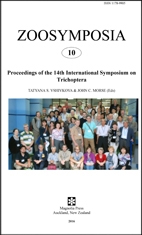Abstract
We focused on the relative number of flying adult caddisflies on the river surface captured by sticky board traps with the aim of elucidating differences in the distribution pattern of caddisfly larvae along the slope in the middle reaches of the Shinano River. The individual number of adult caddisflies caught increased from April and decreased from October. Even in the same middle reaches of a river, there was a large difference geographically in the species captured. Hydroptila sp. was caught mainly downstream of the Taishyobashi Bridge, Psychomyia acutipennis (Ulmer 1908) in the vicinity of the Taishyobashi Bridge, and Stenopsyche marmorata Navás 1920 upstream of the Awasabashi Bridge. It is known that the slope of the Shinano River bed suddenly becomes less and the flow rate slower in the area from the Taishyobashi Bridge to the Awasabashi Bridge, and it was shown that the species composition and number of aquatic insects caught changes with the change in the slope of the river bed.
References
Botosaneanu, L. (1970) Trichoptères de la Républic Démocratique-Populaire de la Corée. Annales Zoologici Polska Akademia Nauk, Instytut Zoologiczny, 27 (15), 275–359.
Chikumagawa River Office, Hokuriku Regional Development Bureau, Ministry of Land Infrastructure, Transport and Tourism. (2012) Chikuma River Information Room. Available from: http://www.hrr.mlit.go.jp/chikuma/bousai/kasen/suii.html (accessed 15 November 2012)
Hellawell, J.M. (1986) Biological Indicators of Freshwater Pollution and Environmental Management. Elsevier Applied Science, London, 546 pp.
http://dx.doi.org/10.1007/978-94-009-4315-5Hirabayashi, K., Fukunaga, F., Kimura, G., Tsushima, K., Tokioka, T., Denda, M. & Amano, K. (2007) Distribution pattern of caddisfly (Stenopsyche marmorata) larvae in the upper and middle reaches of the Shinano River, Japan. In: Bueno-Soria, J., Barba-Alvarez, R. & Armitage, B. (Eds.), Proceedings of the 12th International symposium on Trichoptera. The Caddis Press, Columbus, Ohio, pp.135−142.
Hirabayashi, K., Kimura, G., Uenishi, M., Fukunaga, Y. & Nakamoto, N. (2005) Seasonal changes in caddisfly (Trichoptera) emerging from slow sand filter beds in Japan. In: Tanida, K. & Rossiter, A. (Eds.), Proceedings of the 11th International Symposium on Trichoptera. Tokai University Press, Tokyo, pp.153−159.
Hirabayashi, K. & Watanabe, S. (1996) Massive flights of chironomid midges (Diptera) found on the shoreline of Lake Kawaguchi, Japan during the spring season. Medical Entomology and Zoology, 27, 223−230.
Ito, T., Ohkawa, A. & Hattori, T. (2011) The genus Hydroptila Dalman (Trichoptera, Hydroptilidae) in Japan. Zootaxa, 2801, 1−26.
Iwata, M. (1927) Trichopterous larvae from Japan. Annotationes Zoologicae Japonenses, 11 (3), 203–219, pls. 1–7.
Kawai, T. & Tanida, K. (2005) Aquatic Insects of Japan: Manual with Key and Illustrations. Tokay University Press, Kanagawa, 1342 pp.
Kimura, G., Inoue, E. & Hirabayashi, K. (2008) Seasonal abundance of adult caddisfly (Trichoptera) in the middle reaches of the Shinano River in Japan. In: William, H.R. & Bajomi, D. (Eds.), Proceedings of the 6th International Conference on Urban Pests. OOK-Press Korlátolt Felelõsségû Társaság, Hungary, pp.177−185.
Kimura, G., Inoue, E. & Hirabayashi, K. (2009) Changes in the species composition and density of caddisflies (Trichoptera) after an excavation work in the middle reaches of the Shinano River, Japan. Japanese Journal of Environmental Entomology and Zoology, 20, 17−26.
Martynov, A.V. (1934) Rucheiniki: Trichoptera Annulipalpia I. Tableaux Analytiques de la Faune de l’URSS, l’Institut Zoologique de l’Academie des Sciences, 13, 1–343.
Merritt, R.W., Cummins, K.W. & Berg, M.B. (2008) An Introduction to the Aquatic Insects of North America. 4th Edition. Kendall/Hunt, Dubuque, Iowa, 1158 pp.
Müller, K. (1954) Investigations on the organic drift of north Swedish stream. Reports of the Institute of Freshwater Research Drottningholm, 35, 133−148.
Müller, K. (1982) The colonization cycle of freshwater insects. Oecologia, 52, 202−207.
http://dx.doi.org/10.1007/bf00363837Nagano Prefecture (2012) The monitoring survey of main rivers and lakes in Nagano Prefecture. Available from: http://www.pref.nagano.lg.jp/mizutaiki/kurashi/shizen/suishitsu/kasen/index.html (accessed 15 November 2012)
Navás, L. (1920 “1919”) Neurópteros (Ins.) del Japón. Revista del la Real Academia de Ciencias Exactas. Fisicas y Naturales de Madrid, 18, 157–164.
Nozaki, T. (2012) Biological assessment based on macroinvertebrate communities—average score system for Japanese rivers. Journal of Japan Society on Water Environment, 35 (A), 4, 118−121.
Nozaki, T. & Yamasaki, M. (1995) Simple method using macroinvertebrate families to assess the biological condition of Japanese rivers. Journal of Japan Society on Water Environment, 18, 943−947.
Schmid, F. (1998) Genera of the Trichoptera of Canada and adjoining or adjacent United States. The Insects and Arachnids of Canada 7. NRC Research Press, Ottawa, 319 pp.
Tanida, K. (2010) Biological Indicator of River Environment. Hokuryukan, Tokyo, 197 pp.
Tsuda, M. (1942) Annual collection of Trichoptera adults at the Kitaogi-bashi, Kamogawa. Zoological Magazine, 54, 262−266.
Ulmer, G. (1908) Japanische Trichopteren. Deutsche Entomologische Zeitschrift, 1908, 339–358.
http://dx.doi.org/10.1002/mmnd.48019080304Wallace, J.B. & Merritt, R.W. (1980) Filter-feeding ecology of aquatic insects. Annual Review of Entomology, 25, 103−132.
http://dx.doi.org/10.1146/annurev.en.25.010180.000535Ward, J.V. (1992) Aquatic Insect Ecology. 1. Biology and Habitat. John Wiley & Sons, Inc., New York, 438 pp.
Watanabe, N. (1995) A history of biological monitoring of water quality with present status and future in Japan. Journal of Japan Society on Water Environment, 18, 932−937.
Wiggins, G.B. (1998) Family Hydroptilidae. In: Wiggins, G.B. (Ed.), Canadian Cataloguing in Publication Data. 2nd Edition. University of Toronto Press, Toronto-Buffalo-London, pp. 71−77.
Wiggins, G.B. (2004) Caddisflies, The Underwater Architects. University of Toronto Press, Toronto-Buffalo-London, 292 pp.
Yamagishi, T. (1977) Life history of the aquatic crane fly, Antocha bifida Alexander (Diptera: Tipulidae, Limoniinae). Nara Hydrobiology, 6, 1−22.

